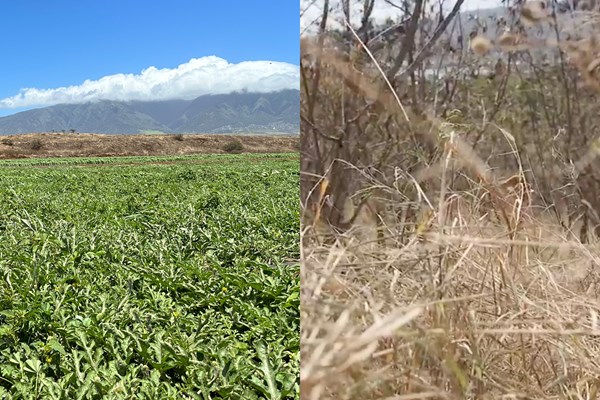Exploring agriculture’s role in preventing wildfires
Aug 31, 2023

Although we have yet to learn the full story behind the tragic wildfire that devastated Lahaina and Kula and took so many lives, there is strong evidence that drought and the recent land-use history of West Maui had a lot to do with the destruction of so much that we cherished on the Valley Isle.
As we have seen throughout Hawaii, when agricultural land goes fallow, vegetation grows unmanaged and provides ready fuel for any potential wildfire. According to Clay Trauernicht, a botanist and fire scientist in the Department of Natural Resources and Environmental Management at UH Mānoa, Guinea grass and fountain grass, along with nonnative scrubland, now cover about a quarter of Hawaii’s land — or about one million acres.
Farmers and ranchers manage forests in ways that provide natural buffers, and can even replenish the ecosystems impacted by wildfires. Irrigated bands of farm and well-managed pasture lands are less likely to burn than dry brush or, as on Maui, fields of 6- to 10-foot Guinea grass. Further, the wildland/urban interface (the area where developed areas, roads, and community infrastructure abuts undeveloped land) is where the majority of wildfire ignitions occur in all of Hawaii. Because of this, these wildland/urban interface areas often experience the greatest risk of loss of property, life, and natural resource function due to wildfire. Farmers and ranchers are typically in these areas, so they act as a frontline of defense against wildfire by managing the land between wildland and urban.
However, using agriculture to prevent wildfires — not to mention increase our food self-sufficiency — requires a significant investment to operate and maintain efficient water systems and develop new water sources.
Given recent trends in decreasing rainfall in Hawaii and the increasing severity of droughts, it makes sense to not only use water wisely, but to leverage it to serve more than one purpose — recycling it whenever possible. It makes environmental sense to consider the development of recycled water to irrigate green bands of farms and pastures around populated areas as fire breaks.
The recovery phase following these devastating fires will be a long one. It goes without saying that rebuilding the right way will demand that such efforts are led by the Maui community. A community-driven infrastructural plan leveraging agriculture to address wildfire risks — not to mention food security — makes a lot of sense. Moreover, it can empower Maui to not just rebuild, but to build back more resilient.
6 ways ag helps with wildfire prevention
- Incorporating Managed Grazing and Livestock Oversight: Farmers/Ranchers can integrate controlled grazing methods involving animals like cattle, goats, or sheep. This approach aids in reducing the buildup of dry vegetation, which can serve as fuel for wildfires. Skillful management of grazing helps keep vegetation levels controlled, thus lowering the risk of intense wildfires.
- Initiating Firebreaks by Farmers: Farmers/Ranchers often take the initiative to establish firebreaks through practices like cultivation or consistent maintenance of vegetation-free strips of land. These firebreaks serve as barriers, slowing down or even halting the spread of wildfires by depriving them of fuel. Additionally, they offer accessible paths for firefighting activities.
- Vigilant Vegetation Management by Farmers: Farmers/Ranchers play a pivotal role in overseeing vegetation around structures, equipment, and infrastructure. This proactive approach results in the creation of defensible spaces that are less vulnerable to wildfire damage. By removing dry vegetation and ensuring diligent maintenance, farmers significantly reduce the likelihood of fire propagation.
- Implementing Crop Rotation and Planting Cover Crops: Farmers/Ranchers can adopt practices like crop rotation and the planting of cover crops during non-growing seasons. These strategies contribute to maintaining soil health and minimizing the accumulation of dry, flammable plant materials. Through these actions, farmers limit the availability of fuel for potential wildfires.
- Utilizing Mechanical Methods for Fuel Reduction: Farmers/Ranchers can effectively employ mechanical methods such as mowing, plowing, or mulching to decrease vegetation density on agricultural lands. By doing so, they actively diminish the amount of fuel accessible to potential wildfires, thus mitigating the risk of rapid spread.
- Ag Water Systems: According to the 2014 Western Maui Community Wildfire Prevention Plan (CWPP): “There is a complex agricultural infrastructure of irrigation ditches and pipes that could be maintained and retrofitted with adaptive housings to increase the suppression capacity and water resource options for Maui Fire Department and DOFAW (Division of Forestry and Wildlife) firefighters. This topic came up often through conversations related to the CWPP. As land use continues to shift away from agriculture, the legacy water infrastructure could serve an important function as a water resource with appropriate attention and funding.”

